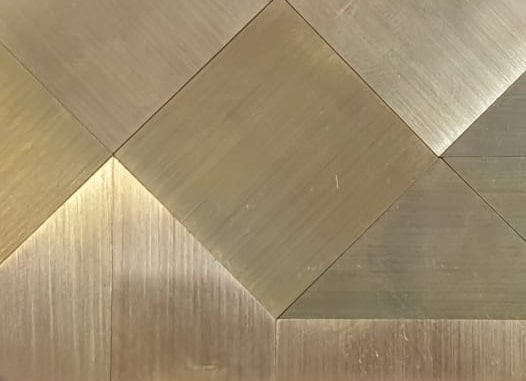
Smithing, sawing, filing, gold and silver
What does an apprenticeship as a goldsmith look like?
You are enthusiastic about jewellery and design. You have noticed that you can work with concentration and are technically fit. You have already done an internship with a goldsmith and realised that this work appeals to you. Then you will find some information about the German apprenticeship procedure here.
You can do a 3.5-year apprenticeship with a master goldsmith. There you will learn all the practical and technical skills you need for the job: how to work with different metals, how to saw, file, solder, forge and much more.
In addition you also have to go to a craft school, which you attend weekly or in blog classes. There you will learn about the necessary theoretical subjects such as metallurgy, gemmology, mathematics, goldsmithing techniques and quite a few more and deepen your handcraft knowledge over time.
These are examples from the first year practical training
The additional practical skills needed
Subjects such as hand drawing, 3D modelling programmes, sculptural design, design drafting and art history are also taught there. So it's a very comprehensive programme.
What about apprenticeships in a goldsmith's workshop?
It is good to apply for an apprenticeship very early on, as only very few goldsmith studios offer apprenticeships. The training always starts in August.
Why are there so few apprenticeships?
The reasons are usually very simple. Often the goldsmith workshops are only run by the owner and are very limited in space. You have certainly already seen this during your visits. But you need your own work table and your own tools. Where to put an extra table and equipment if there is no space? You are also entitled to a training salary of between 300 and 800 euros. This is simply too high for many small workshop owners. In addition, the goldsmith often does not have the time to teach you the basics of goldsmithing and to accompany you in your advanced work. It takes quite some effort to explain and demonstrate the necessary steps. Well in this time the goldsmith cannot work on the her own pieces to sell.
What can craft schools offer you as an alternative?
In addition to the unique system of training with a Master Germany also has Craft schools where you can also graduate as a goldsmith. This is a perfect alternative if you cannot find a training place in a goldsmith's studio. Here, too, training usually starts in August. The application deadlines are as early as February/March. This is followed by an entrance examination on site. In the workshops of the schools you learn about the different processing methods with special machines and equipment. You can use all this while working on your training task pieces and your first designed jewellery objects. The drawing bench for wires, laser welding, the muffle furnace and the 3D printer are all helpful tools. These are 'tools' that are not profitable for many goldsmiths as they might not need them very often or are too expensive in the acquisition. The Craft school does not offer you the possibility to have contact with real customers and working on specific orders and repairs which is also a part of your job as a goldsmith with your own studio.
General information about the craft schools.
There are 5 specific craft schools in Germany where they not only offer a goldsmith course but also other craft classes – e.g. to become a silversmith, metalsmith or glassmaker. At these 4 school in Hanau, Kaufbeuren-Neugablonz, Kaiserslautern and Schwäbisch Gmünd you spend your entire training period of 3 to 3.5 years on site as all the theoretical subjects classes and the practical training is integrated into the full school programme.
At the goldsmith school in Pforzheim, the theoretical and design-oriented part is taught during the first 2 years. After that, you have to complete your remaining 1.5 years practical training in a goldsmith's workshop.
During the training period, there are various tests which you have to pass which than allows you to enter the next year. 4-6 months before the end of your apprenticeship you will start with your final goldsmith task: your self-designed and forged jewellery piece, which you will present to the members of the Goldsmith department of the Chamber of Crafts.
Just a glimpse of work task pieces and personal design ideas
What opportunities do you have after you graduate?
You can now work as a Goldsmith at the workshop or jewellery company where you did your apprentice ship or you can apply for a new job somewhere else. As you gain experience and consolidate your skills, your field of work will also change.
As in all crafts profession in Germany, there is an official further training program to achieve your degree as a master craftswoman. During this course you deepen your skills and expertise and learn the basics of business management. The qualification also allows you later on to take apprenticees and to be able to train them yourself according to the german goldsmith standards.
This specific degree class is offered by some Chambers of Skilled Crafts and vocational schools in a part-time or full-time format.
Some vocational schools also offer an additional 2-year gem-setter training. This is a highly specialised job that involves, among other things, unique processing techniques and a specific knowledge about gems and their properties.
Further education as a 'designer in crafts' gives you the opportunity to deepen your design skills at some academic classes offered by the Chambers of Crafts or special study programmes at specific Craft colleges.
As you can see the German system offers quite a variety of additional training and specific classes. In other countries you have to sign into a College program to achieve your Bachler of Art degree.
In Germany learning about the craft techniques is a very important part of the goldsmith education and this is why you start as an apprentice.
If you want to get more involved in the design process or give your work an artistic direction after you goldsmith degree, than some art colleges and design universities offer you this option. You can find suitable universities in Germany as well as in other European countries.

Profession: Goldsmith
1.step:
apply for a 3.5 years apprenticeship
Where:
at a Goldsmith workshop or
a specific Craft school
Abilities:
you need craftsmanship interest, fine motor skills, concentration and design ideas
WIASOLA advice:
do an internship with a goldsmith or attend a goldsmith's course - then you will notice whether the profession meets your expectations
Craft Schools:
- Staatliche Zeichenakademie Hanau http://p102754.typo3server.info/
- Staatliche Zeichenakademie Hanau http://p102754.typo3server.info/
- Goldschmiedeschule Pforzheim https://goldschmiedeschule.de/unsere-
- Meisterschule für Handwerker Kaiserslautern http://www.mhk-kl.de/index.php?id=goldschmiede
- Berufskolleg für Design, Schmuck und Gerät in Schwäbisch Gmünd https://www.gs-gd.de/berufskolleg-fuer-design-schmuck-und-geraet-128nelement
- Staatliche Berufsfachschule für Glas und Schmuck Kaufbeuren-Neugablonz https://berufsfachschule-neugablonz.de/ausbildung
Have a Look:
A ring design made of silver sheets and plexiglass.
This is a tailor-made sawing exercise and simple soldering from the 1st semester of the goldsmith training in Hanau.


WIASOLA tip after graduation:
Apply to various organizations (scholarships) or local craft organizations (competitions).
In Germany as well as in other countries the trade organisation will offer a unique program. This is only one example:
https://www.hwk-swf.de/artikel/designtalente-handwerk-nrw-2022-jetzt-mitmachen-38,0,792.html